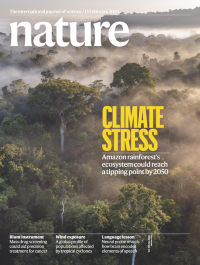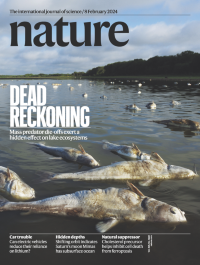Volume 626
-
No. 8001 29 February 2024
Tale of tailsOne of the most notable changes along the evolutionary lineage to apes and humans is the loss of the tail — an attribute that distinguishes them from monkeys such as the bonnet macaques (Macaca radiata) shown on the cover. Yet the genetics underlying this development remain obscure. In this week’s issue, Bo Xia, Jef Boeke, Itai Yanai and colleagues reveal that a single transposon might have contributed to tail loss in apes and humans. The researchers found that the insertion of the transposon into the non-coding part of TBXT, a gene important for tail development, leads to alternative splicing of the gene. When the DNA is transcribed into RNA, this splicing removes part of the protein-coding portion of the gene, which the authors show could have contributed to tail loss.
Focal Point
-
No. 8000 22 February 2024
Smoke alarmEveryone’s immune system responds to challenges differently. A lot of this is a result of age, sex and genetics, but environmental factors such as lifestyle could also contribute. In this week’s issue, Darragh Duffy, Violaine Saint-André and colleagues explore the effects of 136 environmental factors on the immune responses of 1,000 individuals. Of all the factors studied, smoking had a significant influence, affecting both innate (general) and adaptive (pathogen-specific) immunity. Although the effects on innate immunity disappeared after the smokers stopped smoking, the effects on adaptive immunity continued for many years after quitting, altering the levels of cytokine released after infection, for example.
-
No. 7999 15 February 2024
Climate stressThe cover captures a misty morning in the Amazon rainforest at Alta Floresta in Mato Grosso, Brazil. The rainforest is home to 10% of Earth’s biodiversity and is a key carbon store, helping to stabilize the planet’s climate. In this week’s issue, Bernardo Flores and colleagues reveal that climate and land-use stresses could push the rainforest past a tipping point as early as 2050. The researchers probed five causes of water stress — global warming, annual rainfall, seasonal intensity of rainfall, length of the dry season and deforestation — using palaeorecords, climate models and observational data. Their analysis reveals that 10–47% of the Amazonian forest will be exposed to water stresses that could cause the ecosystem to transition, potentially driving it past a tipping point after 2050, beyond which ecosystem collapse could occur.
-
No. 7998 8 February 2024
Dead reckoningThe cover shows a mass die-off of fish in Lake Corpus Christi, Texas. Such events are becoming more common, but the full effects of predator deaths on food webs has been unclear. In this week’s issue, Simon Tye and colleagues reveal that, somewhat counterintuitively, mass mortality of predators in a lake ecosystem can actually stabilize the food web, masking the effects of predator removal. The researchers created an artificial lake environment featuring phytoplankton, zooplankton (which fed on the phytoplankton) and fish (which fed on the zooplankton). When the fish died off, instead of the zooplankton proliferating wildly owing to reduced predation, decomposition of the deceased fish helped fertilize the phytoplankton, thereby boosting their numbers and helping to stabilize the food web.
-
No. 7997 1 February 2024
Significant ottersThe cover shows a sea otter (Enhydra lutris) off the coast of California. This species is a top predator but was hunted to near extinction. In this week’s issue, Brent Hughes and colleagues reveal that the recovery of the sea otter population in a California salt marsh has slowed salt marsh decline in the area. It has long been suspected that the recovery of top predators would have a cascading effect on the vegetated ecosystem, but the issue remains controversial. The researchers monitored Elkhorn Slough estuary over several decades and found that erosion of the salt marsh edges slowed in line with the rising otter population because the otters preyed on the burrowing crabs that damage the marsh. These results suggest that restoring top predators could have positive effects on vulnerable coastal ecosystems.





